WHERE AND WHEN
From Wednesday 7th June to Sunday 10th 2023 the ancient imperial city of Nürnberg/Nuremberg welcomed 100,000 people of all ages to the great biennial Protestant church festival. Kirchentag means Church Day or Church Conference. This was my tenth Kirchentag; I am hooked!
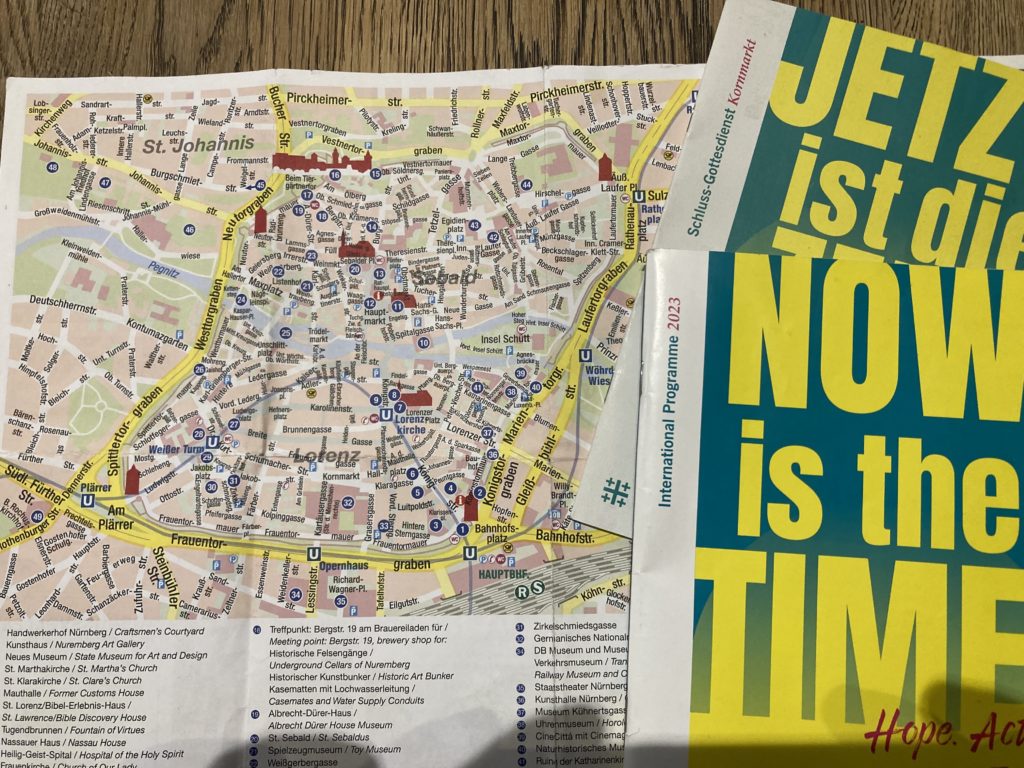
Nürnberg (they have a really thick local accent) was one of the most important cities of the Holy Roman Empire, with a massive castle built in the 12th century. Bombed to bits in an hour in January 1945 and further ruined in a fierce battle in April, it has been remarkably restored.
WEDNESDAY – GETTING STARTED
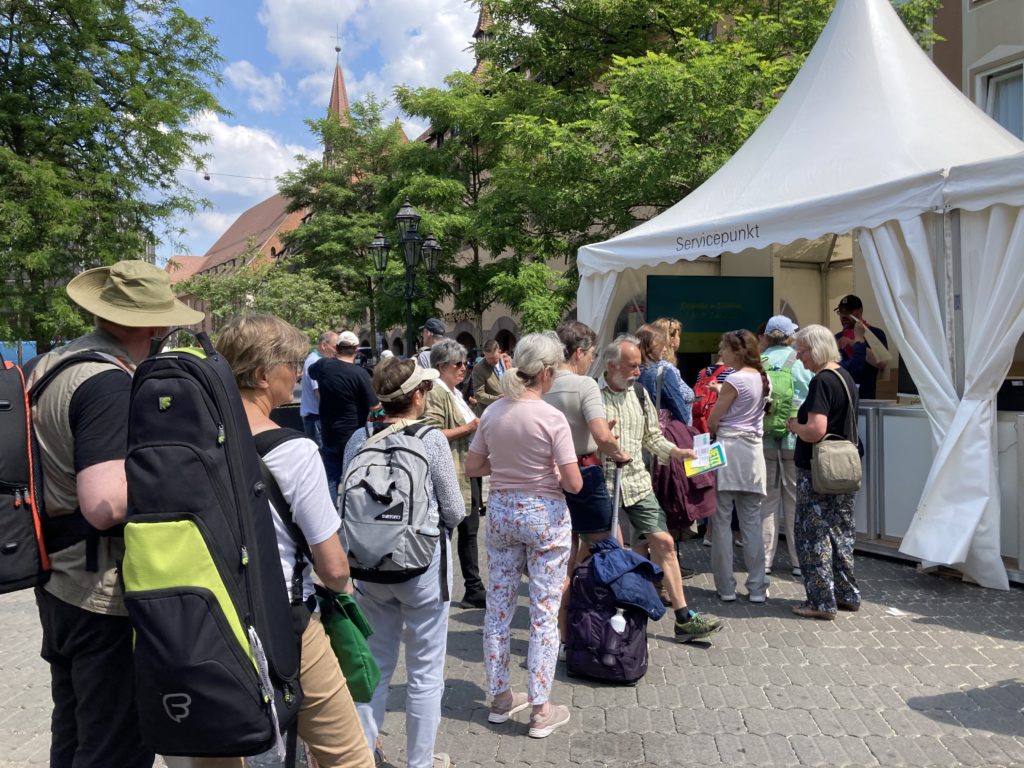
I arrived the day before, fortunately, because getting my Kirchentag ticket was aggravating. I went to a ‘Service Point’ next morning, was told to come back at 2.00. I returned and queued, and was then told that the printer was not working and that I should come back in an hour. I explored the two main churches in the Old Town, St Lorenz and St Sebald. The churches are 14th-15th century. The castle was built by the emperor in the 12th century and was the strongest castle in Germany. But that did not stop Nürnberg being a free city which ran its own affairs.

St Sebald, the patron saint of Nürnberg, was an Anglo-Saxon monk in the 10th century (we think) who set up as a hermit in the woods outside the town, and converted the locals. How? Presumably by prayer and individual conversations. His shrine is still in the church.
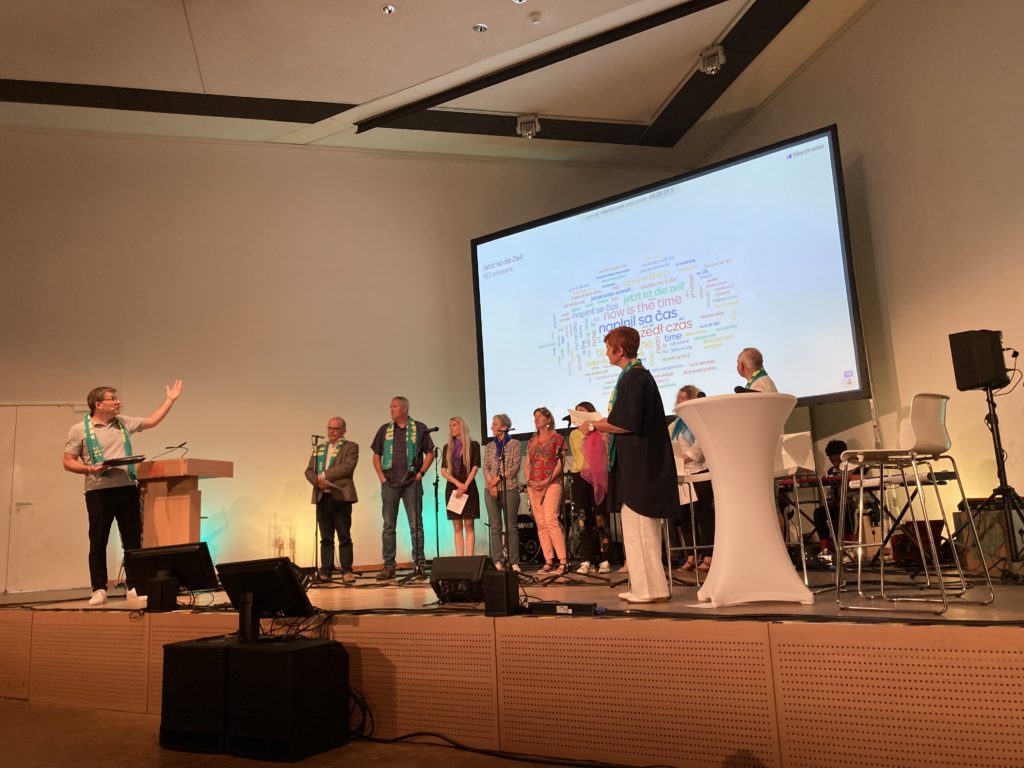
I returned to the service point to find that the printer was still not working. So I walked for twenty minutes to another service point and got it. A bit late for the Opening Service in one of the town’s squares – it was hot and crowded, but then I went to the nearby hall where all the international guests were welcomed. I met an English engineer called David. We went to find the street party, and had good German sausages and beer.
THURSDAY – MISSED TALKS BUT GREAT MUSIC
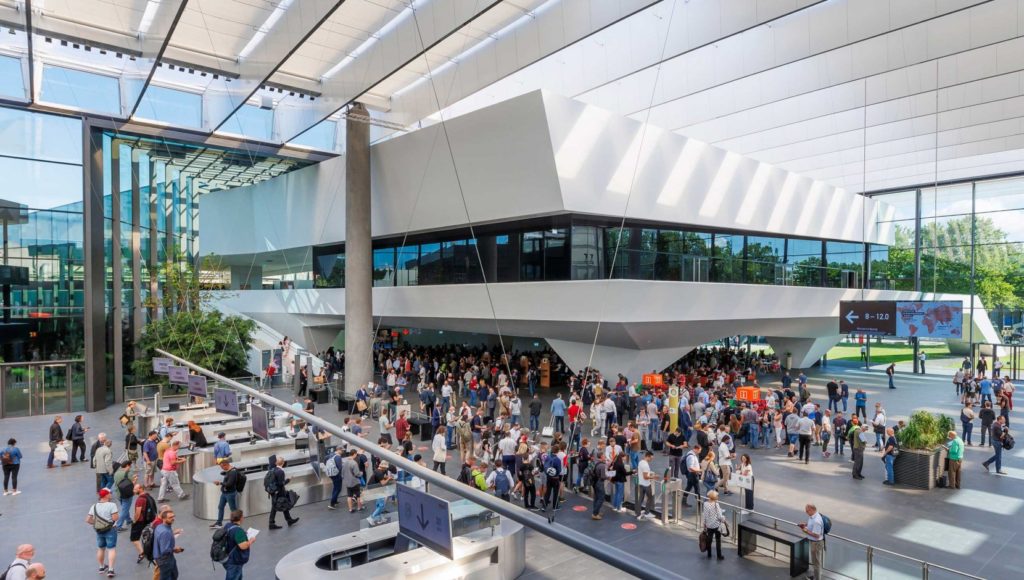
Today Steinmeier, the President of Germany, gave a Bible study on the wedding at Cana.
‘The best laid plans of mice and men /Gang aft a-gley’ (Robbie Burns). You’ve got to be ready for that in the Kirchentag. I had planned (ha!) to go to a Jewish-Christian Bible study at 9.30 and stay in that hall for the talks on ‘Explaining the New Testament in Jewish terms’. Interesting! BUT the hall at 9.30 was ‘überfüllt’, full up; and at 11.00 the simultaneous translation into English, though advertised, did not happen. So at 9.30 I went to a Bible Study for people with learning difficulties and learnt a great chorus, ‘Gottes Liebe ist so wunderbar…’, with actions. At 11.00 I simply went to the International Centre for free coffee and chat with whoever was there. I met a doctor of complementary medicine, who offered to translate my book into German, and another doctor who offered to come with me on Thursday morning to interpret the talks for me. Truly, ‘Gottes Liebe ist so wunderbar…’
The afternoon I spent walking round the ‘Market of Possibilities’. My poor German hindered me from engaging, but I did have a nice chat with people from the Lutheran Church in Prague and told them a Czech joke. I wanted to talk to a German publisher about my book ‘Jesus the Troublemaker’ (see the home page) but that did not happen.
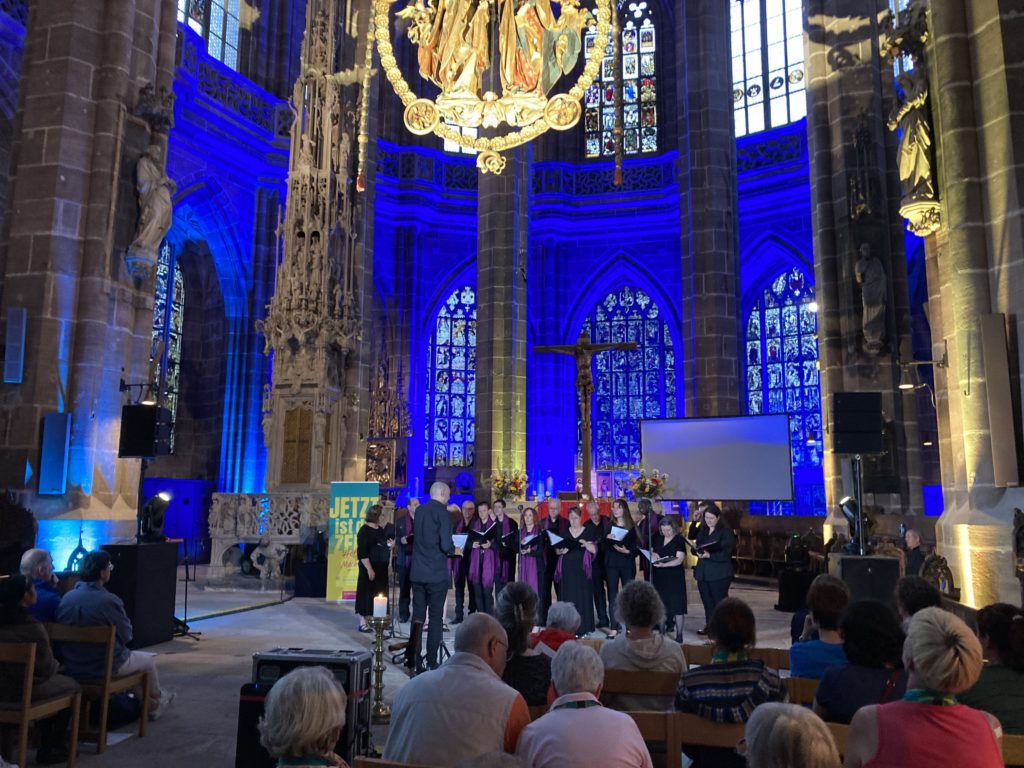
At 4.00 I made my way to the Old Town for Evensong in English. I arrived early (not my trademark) because the programme said it started at 5.00, whereas it actually started at 5.30. A really great service with marvellous singing of psalms and choral-type hymns.
From St Lorenz I scooted to the other part of the town to St Sebald for a performance of Mendelsohn’s ‘Lobgesang’, ‘Hymn of Praise’, sometimes called his second symphony, 70 minutes of inspiring music with real spiritual meaning. I understood it because I could follow the lyrics in German and English on my i-phone. It ended with a great worship ear-worm (which it also starts with in the orchestra): ‘Alles was Odem hat, lobe den Herrn’, ‘Let everything that has breath praise the Lord’.
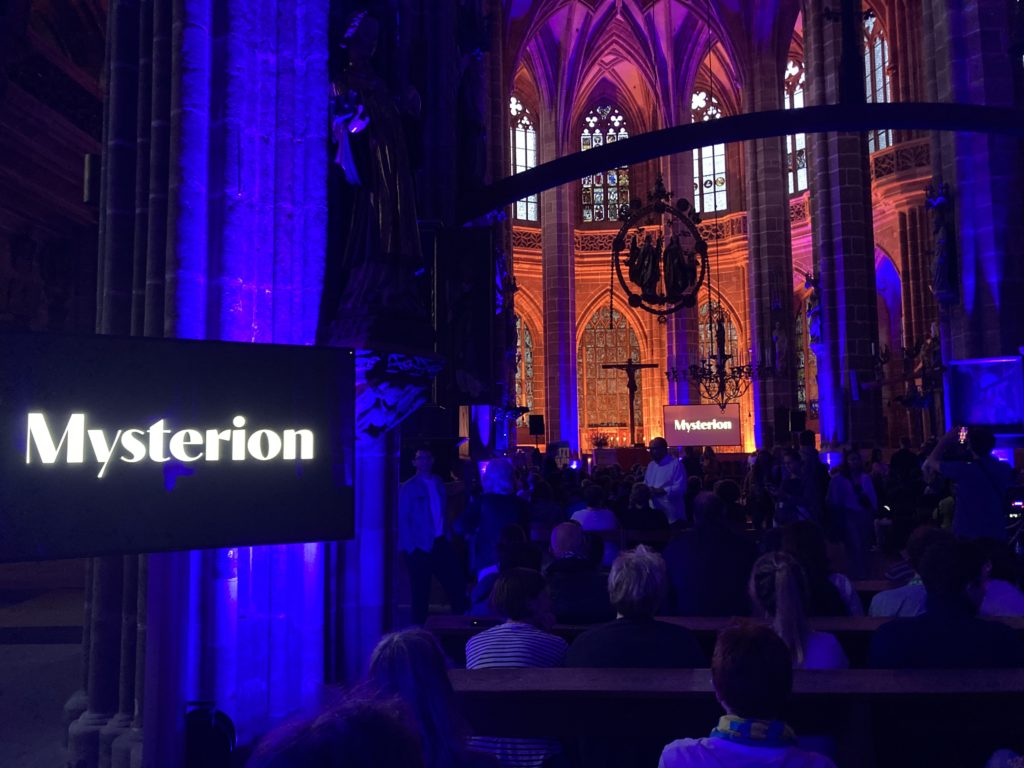
Back to St Lorenz for ‘Mysterion’ at 9.30, Holy Communion with electro-chill music. A darkened church with a few large screens following almost wordlessly the structure of a communion service. Very prayerful. It ended with proper communion: bread and wine followed by open-ended chatting together in small groups. I think Jesus would have felt really at home.
At 11.00 I had a takeaway supper – an enormous chicken shawarma in a roll, then home to bed.
FRIDAY – SERIOUS STUFF
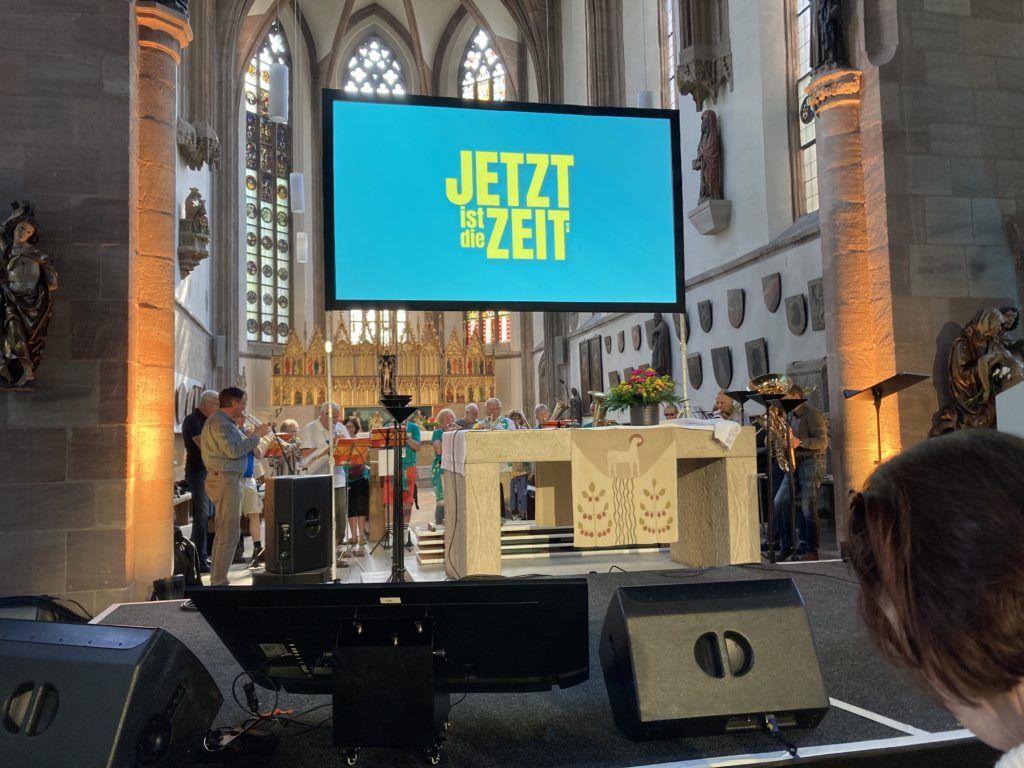
I met Eva my interpreter at the small medieval church of St Jakob in time for the Bible Study on Genesis 50.15-21, the story of how after their father Jacob had died, Joseph’s brothers were terrified that he would now take revenge on them. Joseph responded, “Am I in the place of God? Even though you intended to do harm to me, God intended it for good…”
The talk at 11.00 was entitled ‘Theology between crisis and catastrophe’. It was led jointly be a Protestant and a Roman Catholic theologian. Some of the points I noted:
- There are no easy answers when it comes to crises
- We need to be open to society and open to the Spirit.
- We also need stubbornness and hope in an open future.
- In the USA there are 37.9 million people living in poverty.
- We have a crisis here in Europe. Other parts of the world already face catastrophe.
- By 2030 there will be a ‘Death Zone’, a belt 2000km wide around the equator, including India. What then?
There followed a Midday prayer largely in English which reflected on the nature of the Church. Here are some quotes:
- “I connect to you, you connect to me, then we build a building around that.”
- “If there is no community being built, I suggest that that is not church.”
- “To be a sanctuary, the church needs a living spirituality.”
- “Stay alert.”
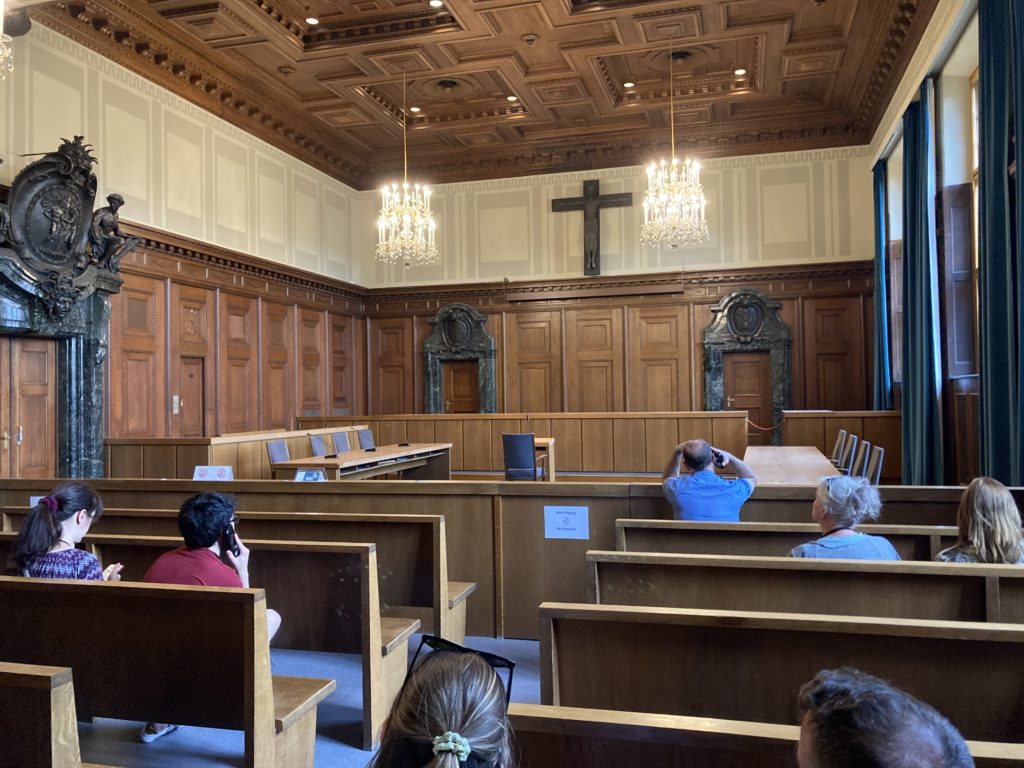
Outside the church was a food tent where I had frikadeller, (a sort of mince cutlet) sauerkraut and beer. Then some sight-seeing, namely the Palace of Justice where the Nuremberg trials were held 1945-1946. This is where the leading Nazis were tried, and which became the model for today’s international justice system. Very interesting to see the actual courtroom and the exhibition on the floor above, which in true German fashion was exhaustive. A serious place.
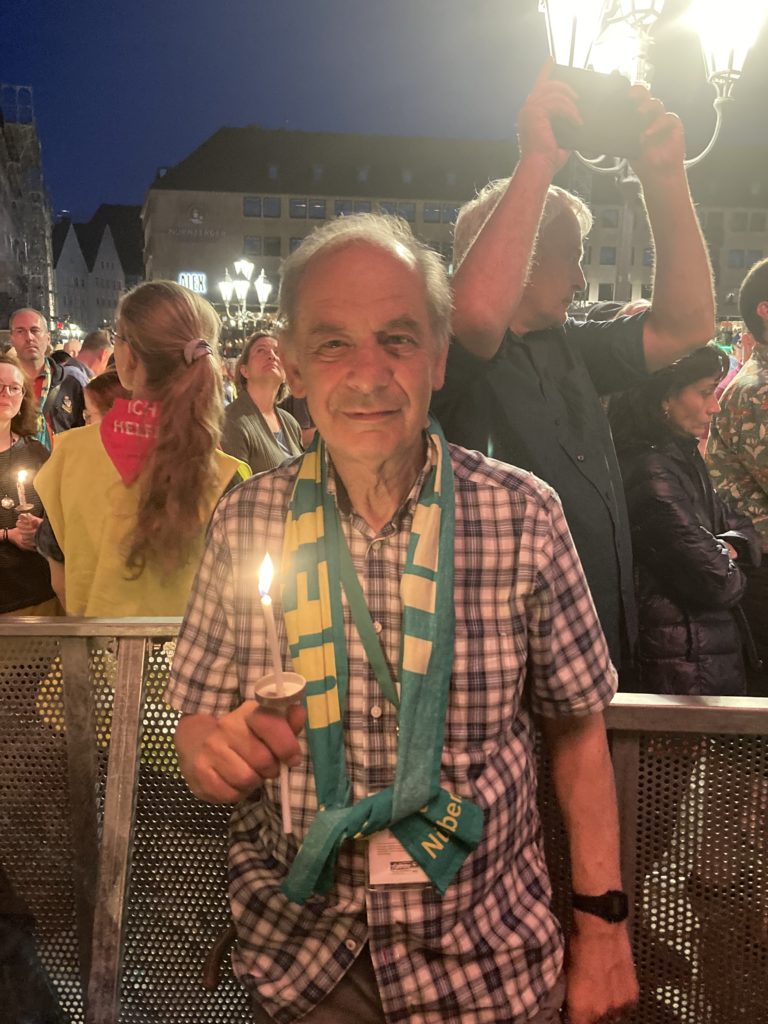
I then missed two music sessions, one of Argentina tango, the other of Nürnberg’s own baroque composer Pachelbel. Instead I went to a communion service in English. Great music from an African choir, and a passionate sermon by a black US woman priest, who constantly exhorted us to “roar like a lion” (Amos 3.8). But apart from the communion prayer, there was no mention of Jesus which I thought was a pity. They had a well-known Hindu prayer (unattributed) as their last hymn. However, I ended the day on a high note, at the Night Prayer in the Hauptmarkt, Main Square. Absolutely full of people all holding candles and singing Taizé-type songs. A Tanzanian bishop was one of the leaders, and he taught us how to say ‘Sleep well’ in Swahili, “La la salaama”. Delightful!
SATURDAY – DOOMSDAY + FRIENDS
Today Scholz, the German Chancellor gave a speech on ‘Shaping things together in turbulent times’.
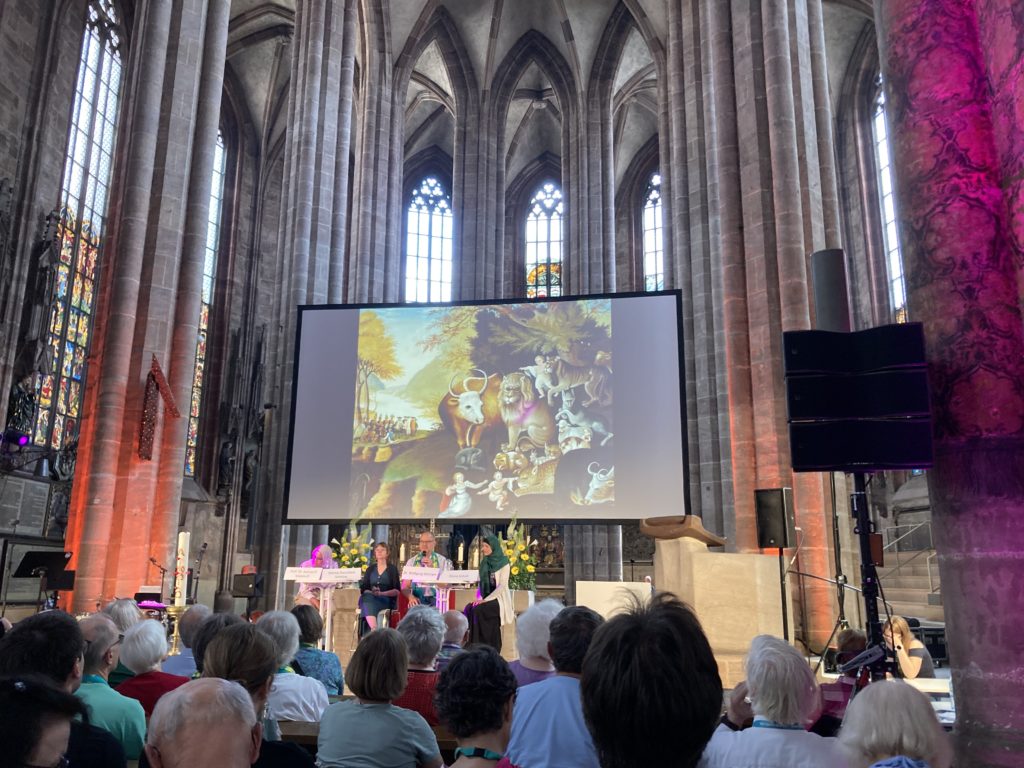
The main event for me today was a panel session in St Sebald entitled ‘Even if doomsday comes’ – shaping the future in an apocalyptic age’. I heard it translated into English through headphones. An Islamic woman theologian reflected on the story of Noah and the great flood, which is in both the Bible and the Qur’an. The prophet Mohammed said, “The whole world is a mosque” and so needs to be treated with respect. A Lutheran pastor talked about the book of Revelation which gives a series of savage pictures of what is coming, but looks forward to a new heaven and a new earth; its fundamental message is a call for endurance. During question time I wrote a question, in English, referring to what I heard the day before about a death zone around the equator by2030 and how we can respond in our worship, and this was chosen. A woman from Greenfaith, Germany, replied that in order to stay faithful to God, the Church needs to learn to sing songs of lament, just like so many of the psalms.
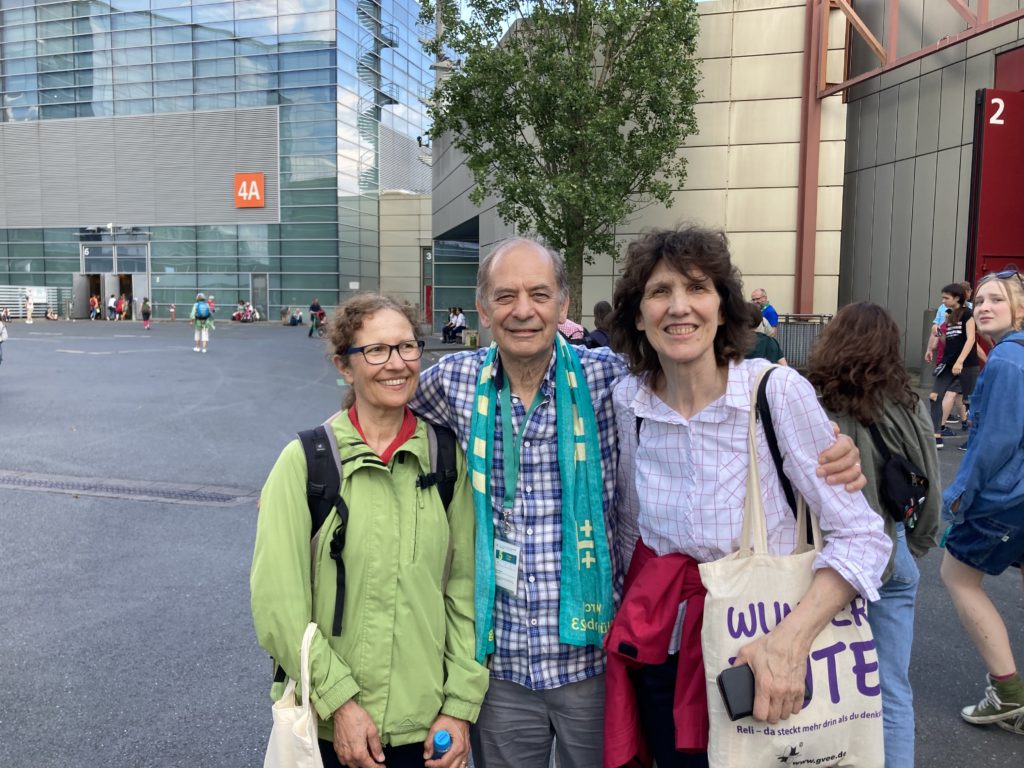
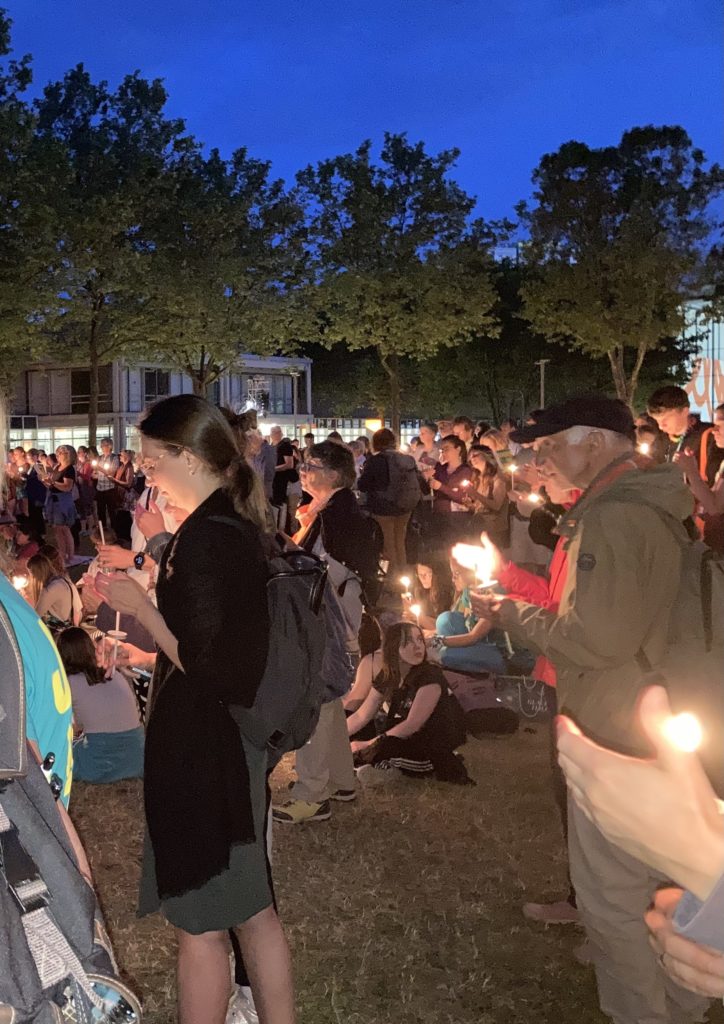
I went back to the International Centre where I had arranged to meet my friends Waltraud and Barbara and spent most of the day with them. I had met Waltraud at my very first Kirchentag event, the opening service of the 1993 Kirchentag in Munich. I then went back to St Lukas for an evening service according to the Romanian Orthodox Church. A lot of the prayers I use myself I found there translated into German. A real gift. This was followed by another bratwurst, sauerkraut and beer. I went back to the Messe and I walked straight into my friends. Barbara wanted to go to a ‘Night of Song’ so we did that. We heard two very different singers, the first pleasant and tuneful, the other energetic and edgy. One of his lyrics was, “Ich verstehe nur / zerbrechlich seid ihr.” – “I only understand one thing, that you are fragile/breakable.” We were not impressed by the next singer so we left and found ourself in the central court during a delightful night prayer with gentle music and candles for everyone. A wonderful ending to the day.
SUNDAY – WORSHIP AND THE CITY
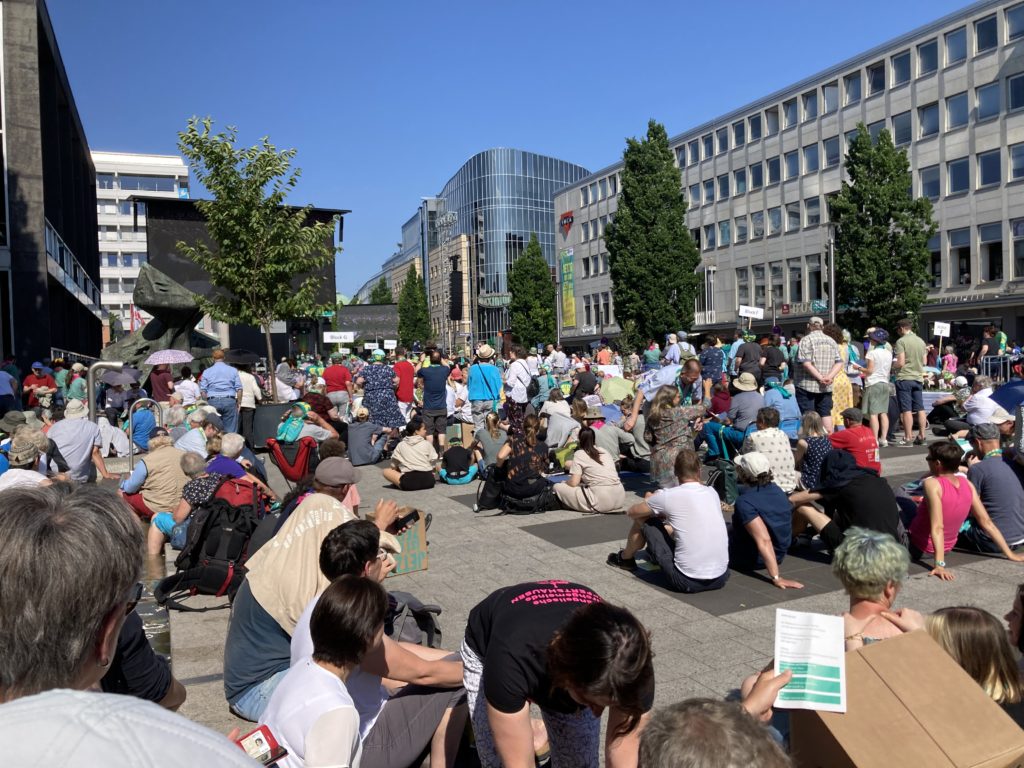
A very hot morning in the Corn Market with several thousands there in the hot sun for the closing service in simple German, with brass bands and great singing. A great feeling that we were all together as a Christian people. Fortunately I had my sun hat and was able to sit on a small stone pillar with my feet in cool water – the most comfortable concluding service I have been at.
I spent the rest of the day in two museums. The German National Museum was full of cultural treasures, like this rich merchant’s dining table centrepiece – a gold-plated silver model trading ship.
Then to the City Museum. There I learnt an interesting aspect of the city’s history, how very early in the Reformation the city became Lutheran, but in quite a moderate way so that the Emperor could accept it and there was little destruction within the churches.
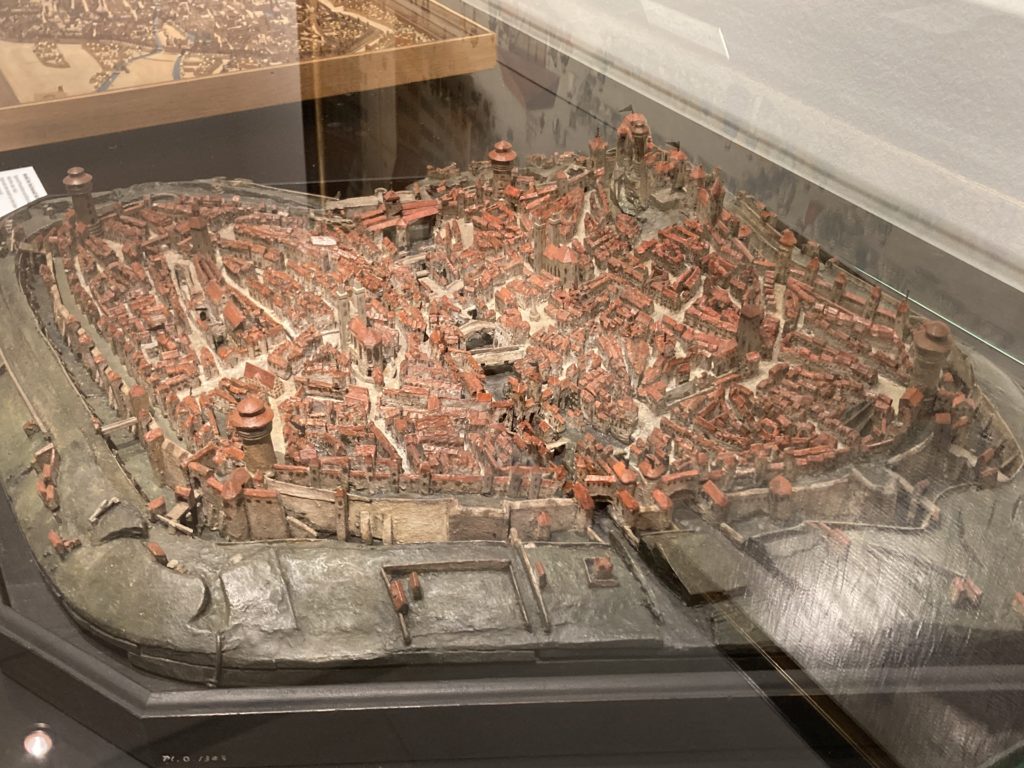
It also had a very sobering exhibition of the destruction of the city in 1945 by bombing in January 1945 and by fierce fighting in April that year.
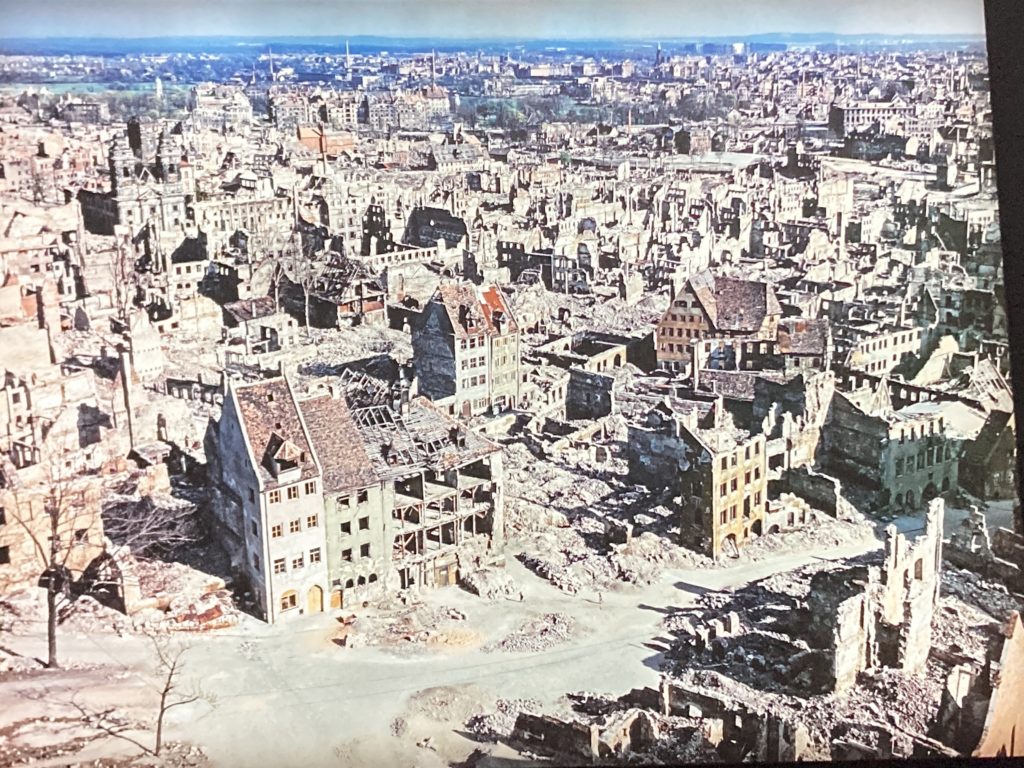
In the evening I strolled by the river in the east of the city and saw Nürnberg at its most romantic. I also found a large beer garden in a meadow where I had a beer I then discovered a 23 screen cinema! Definitely a city worth visiting when you are next in Bavaria. For more info see https://www.kirchentag.de.
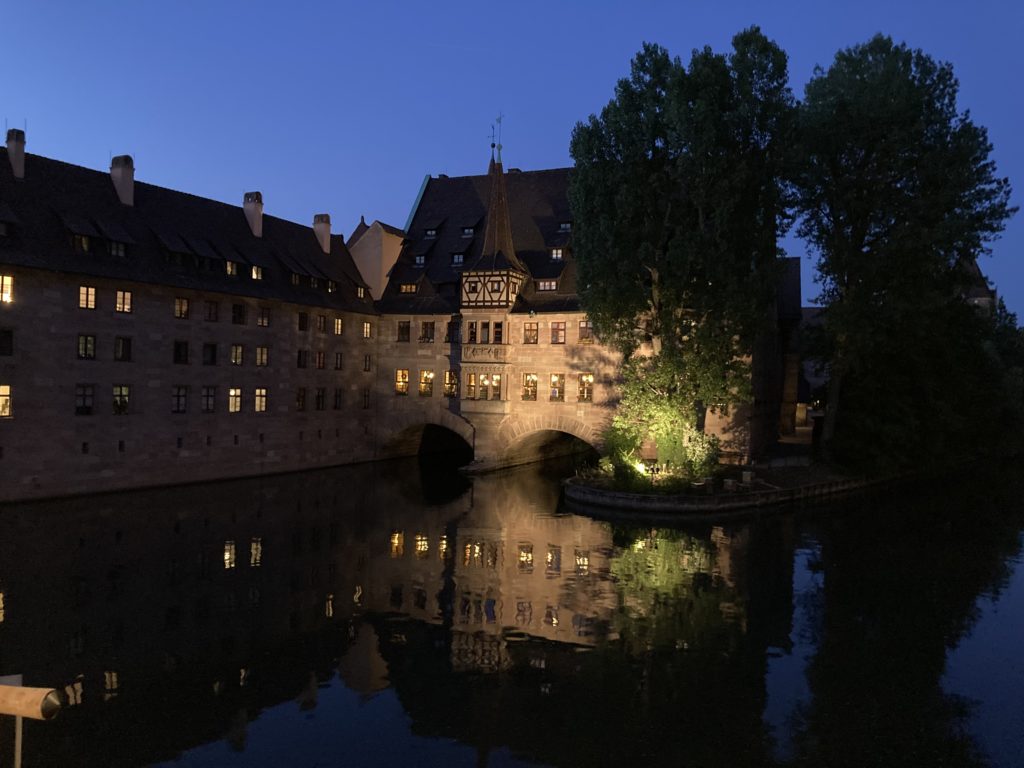
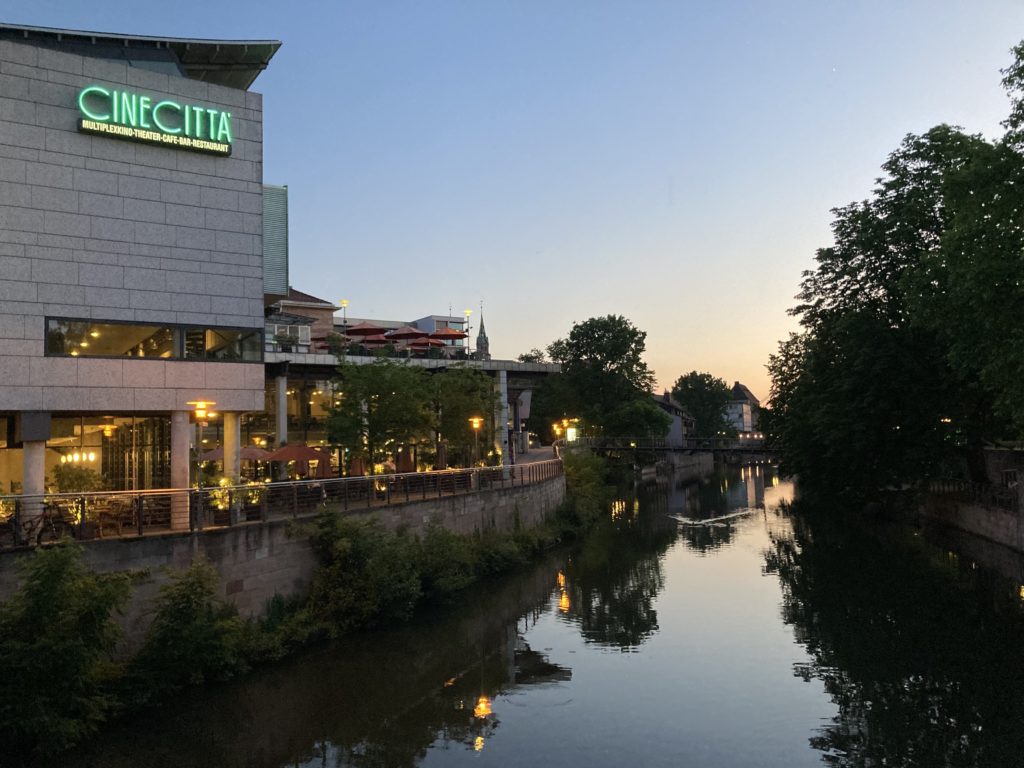
Viel Spass / Have fun
Andy
